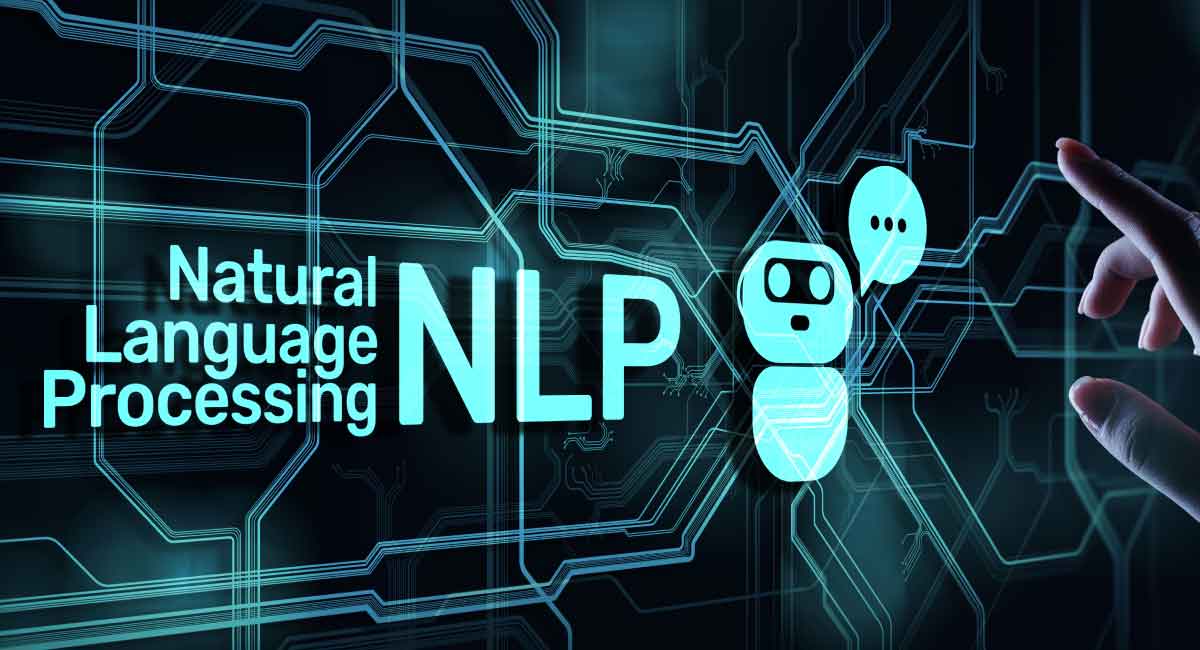Every day, our society inches closer to technological innovations and devices initially found only in science fiction stories, films, and television shows. One of the more fascinating aspects of these future societies is the ability for people to communicate with their machines as if the latter were people. In those instances, we’re witnessing natural language processing applications at work, NLP for short.
Today, there are countless NLP applications, with more coming every day. This article explores a handful of the top natural language processing applications. Read on and prepare to be amazed and informed. Also, learn how online AI and machine learning training can give you practical exposure to these applications.
But before we show you that NLP applications are everywhere, let’s define the term.
What is Natural Language Processing?
Natural language processing is a branch of artificial intelligence (AI) focused on teaching the human language (and all its complexities) to computers so that machines can comprehend and interpret human languages, eventually leading to a greater understanding of human communication. Natural language processing combines many diverse fields, such as artificial intelligence, human-computer interaction, computational linguistics, etc. Many different NLP methods exist for understanding human languages, including statistical and machine learning methods. These methods involve breaking down human languages into their most basic pieces, understanding how these pieces relate to each other, and then putting them together to create meaningful sentences.
To put it briefly, natural language processing is a subfield of machine learning technology that gives machines the ability to interpret, manipulate, and comprehend human language.
And, as we’re about to see, the natural language processing applications are many and varied!
Also Read: Machine Learning in Healthcare: Applications, Use Cases, and Careers
NLP Applications with Examples
- E-mail Classification and Filtering. Despite the rapid increase in the popularity of chat apps, online team conferencing, and other instant communication utilities, e-mails remain the most significant method for professional communication. However, many people still get thousands of promotional e-mails they want to avoid reading. Thankfully, e-mails today are automatically categorized into three sections: Primary, Social, and Promotions, which means users never have to deal with the Promotional section if they choose. But how does this classification work? E-mail services employ natural language processing to identify each e-mail’s contents using text classification to classify each e-mail correctly. This classification method could be better since a few promotional newsletters can still end up in the Primary section, but it beats the alternative. In more advanced cases, some organizations use specialty anti-virus software equipped with natural language processing to scan their incoming e-mails to detect patterns and phrases that could betray a phishing attempt against their employees.
- Chatbots. Chatbots are programmed with AI and machine learning to interact with humans in a way that makes them sound like humans. Chatbot complexity varies, and they can do tasks ranging from simply responding to given keywords or holding entire conversations that make it difficult to distinguish the machines from real people. Chatbots are developed with machine learning and natural language processing, so they are equipped to understand the complexities of the English language, find the meaning of the sentence, and learn from their interactions with people, improving with time. Chatbots typically function in a two-stage manner. First, the chatbot identifies the question’s meaning and collects all the data the user needs to answer the question. Then, the chatbot gives the appropriate answer.
- Voice Assistants. Voice assistants are everywhere these days! Whether it’s Alexa, Siri, or Google Assistant, many people use voice assistants to place calls, schedule meetings, create reminders, set alarms, play music, explore the Internet, etc. Voice assistants have definitely made life much easier, but how do they work? Voice assistants use a complex mix of speech recognition, natural language processing (NLP), and natural language understanding to comprehend what people are saying and then act on it. A voice assistant’s ultimate long-term goal is to be a bridge between humans and the Internet, providing all kinds of services using just voice interaction. The process could be better, however, and sometimes the assistants need to know precisely what you mean, but give the technology time; it keeps improving!
- Language Translator. Do you want to translate a text from English to Spanish, but don’t you don’t speak or read Spanish? Then check out Google Translate! While the tool isn’t 100 percent accurate, it’s still a solid way to convert text from one language to another. Google Translate and other related translation tools employ a technique in Natural Language Processing known as sequence-to-sequence modeling. This technique lets the algorithm convert a sequence of words from one language to another, accomplishing a translation. Years prior, language translators used statistical machine translation (SMT), which analyzed millions of documents previously translated from one language to another (English to Spanish in our case), then looked for the basic vocabulary and familiar patterns of the language. However, this earlier method isn’t accurate, especially when compared to sequence-to-sequence modeling.
- Sentiment Analysis. With so much of the world on social media, companies turn to this natural language processing application to determine how particular types of users feel about a specific topic, service, product, deal, etc. Businesses use natural language processing, text analysis, computational linguistics, etc., to understand the users’ general opinions or sentiments about their products and services and determine whether their sentiments are good, bad, or indifferent. Companies use sentiment analysis in many ways, such as keying in on the emotions of their target audience, understanding product reviews, gauging their brand sentiment, etc. Governments use sentiment analysis to discern public opinion on policies or catch potential national security threats.
- Autocompletion in Search Engines. Click on Google and start typing a phrase in the search box. Notice how the search engine often guesses what you are typing and automatically completes the sentence? For example, type “artificial intelligence,” and you will get suggestions such as “artificial intelligence engineer salaries,” “artificial intelligence jobs,” and “artificial intelligence examples.” All these suggestions are provided courtesy of autocomplete, which employs natural language processing to predict what you want to ask. Search engines use their vast data sets to analyze what their users are most likely typing when they enter words, then suggest the most common and likely possibilities. The search engine utilizes natural language processing to make sense of the user’s words and how they are interconnected to create different sentences.
- Grammar and Spell Checkers. Grammar and spelling are vital in everything from writing professional reports for superiors to doing your assignments for a professor. Spelling and grammar count, so having significant errors in your text could get you a failing grade or an unfavorable employment review. That’s why grammar and spell checkers are essential tools for any writer, whether a professional or a student. These checkers can correct grammatical errors and check spelling, offer better synonyms, and enhance the text’s overall readability. These tools can even check for possible plagiarism! And sure enough, these tools employ natural language processing to offer the best possible writing. The NLP algorithms are trained on millions of sentences to better understand the proper grammatical formats. That’s why grammar checkers can suggest correct verb tenses, better synonyms, or a more straightforward sentence structure than what you previously wrote. Some popular NLP-powered grammar checkers include Grammarly, ProWritingAid, and WhiteSmoke.
- Text Analytics. This NLP application employs various linguistic, statistical, and machine learning techniques to change unstructured text data into meaningful data for analysis. While sentiment analysis may sound daunting to some organizations, especially ones with a large customer base, NLP text analytics tools can scour customer interactions like reviews, social media comments, or brand name mentions to see who is saying what. Analyzing these interactions helps brands determine the effectiveness of a marketing campaign or monitor trending customer issues before deciding how to respond or improve service to offer a better customer experience. NLP also helps with text analytics in areas such as finding structure or patterns in unstructured text data and keyword extraction. At the same time, the human touch is preferable and vital for more detailed communication issues; natural language processing can improve our lives by tackling and automating redundant, more minor tasks.
- Urgency Detection. Natural language processing techniques can also help organizations detect a tone of urgency within the text. Data analysts can train an urgency detection model using their organization’s established criteria, so the model can recognize particular words and expressions that imply discontent or seriousness. This process helps companies prioritize the most critical requests and ensure these communications aren’t buried under unresolved tickets. Urgency detection helps companies improve efficiency and response times, leading to a more significant positive impact on customer satisfaction.
- Intent Classification. This natural language processing application identifies the text’s underlying goal or purpose. By analyzing customer interactions such as e-mails, social media posts, or chats, companies can spot the customers ready to purchase. The faster a business can detect and classify these leads, the more opportunities to convert them into customers. Finally, searching for customer intent in social media posts or customer support tickets can warn you of possible churn risks, letting the business respond quickly with a strategy to win them back, if not pre-empt their departure altogether.
Also Read: What is Machine Learning? A Comprehensive Guide for Beginners
Do You Want Training in Artificial Intelligence and Machine Learning?
Natural language processing is just one field in a vast selection of artificial intelligence and machine learning applications. If you want to acquire more vital AI/ML skills, consider this online AI/ML bootcamp. This high-engagement learning experience will teach you fundamental artificial intelligence and machine learning skills, including Python and natural language processing.
According to Glassdoor.com, the average annual salary of an artificial intelligence engineer is $115,655. So, if you’re looking for a fast-growing career that offers a good measure of economic security, consider looking into artificial intelligence and machine learning, and check out this bootcamp as your first step into this exciting new world.
FAQs
Q: What are some typical natural language processing applications?
A: Common NLP applications include chatbots, e-mail filtering, smart assistants, predictive text, sentiment analysis, and social media monitoring.
Q: What is NLP, with an example?
A: Natural language processing is a subdivision of artificial intelligence that focuses on teaching the human language (and all its complexities) to computers so that machines can comprehend and interpret human languages, eventually leading to a greater understanding of human communication. Alexa and Siri are prime examples of natural language processing at work.
Q: What is the primary function of NLP?
A: Break down human languages into their most basic pieces, understand how these pieces relate to each other, and then put them together to create meaningful sentences.
You might also like to read:
How to Become an AI Architect: A Beginner’s Guide
How to Become a Robotics Engineer? A Comprehensive Guide
Machine Learning Engineer Job Description – A Beginner’s Guide






